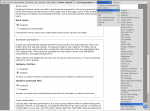
dynamic
SimpleMenu Known Issues
SimpleMenu Disappears
There following are a few of the main reasons why SimpleMenu disappears.
Pop-up Windows
By default, SimpleMenu wants to hide itself in pop-up windows. This is a feature.
The reason is that many websites will open pop-up windows for all kinds of extra-features such as uploading an image or printing some description of an image or the definition of a word or product.
These windows should not include the SimpleMenu bar.
There is a dedicated page giving several different ways to fix this problem on your website.
Menu Overflow
Set Target (dynamic)
Pop one string from the stack. If the string is the empty string, then the next actions apply to the main movie. Otherwise it is the name of a Sprite1 and the followings actions apply to that Sprite only.
- 1. Note that the name of a sprite is specified in the PlaceObject2 tag so as to be able to include the same DefineSprite tag multiple times and still be able to distinguish each instance.
With
The variable references within the following f_size bytes of action are taken as names of members of the specified object o1. When no member of that name is available in that object, the previous With, or the corresponding global variable is queried. This is similar to the Pascal language with instruction or to the Set Target (dynamic) for movies.
Wait For Frame (dynamic)
Pop a value or a string used as the frame number or name to wait for. The frame can be specified as with the Goto Expression. If the frame was not reached yet, skip the following f_skip actions.
WARNING
Set Target
If the string f_target is the empty string, then the next actions apply to the main movie.
Otherwise it is the name of a Sprite and the followings actions apply to that Sprite only.
In order to use a dynamic name for the target, use Set Target (dynamic) instead.
Goto Frame
The playback continues at the specified frame. Frame numbers start at 0 and go up to to total number of frames - 1.
A frame appears at each new Show Frame tag.
For a goto frame with a dynamic frame number, use the Goto Expression action instead.
Get URL2
Pop two strings, the URL (s2) and the target name (s1).
All the usual HTML target names seem to be supported (_top, _blank, <frame name>, etc.) You can also use the special internal names _level0 to _level10. _level0 is the current movie. Other levels, I'm still not too sure how these can be used.
Get URL
Load the specified URL in the specified target window.
When the target is set as "_level0", the current SWF file is replaced by the file specified in the f_url field. The name in the f_url field should be a proper SWF file or the area will simply become black.
When the target is set as "_level1", something special is supposed to happen. I still don't know what it is...
Also the effect of _level1 + an empty URL is ... (to remove level1?)
Delete
Pop one string representing the name of the property to be deleted. Then pop the object from which the property is to be deleted.
In version 5 through 8, it is necessary to Push Data type undefined (0x03)1 before the string as in:
96 04 00 03 00 'a' 00 3A
delete("a");
to delete a global variable.
- 1. Since player version 9, deleting a dynamic (global) variable requires _root (or _global) instead of undefined.
SetTabIndex
This tag defines the tab index of any text object (static and dynamic text objects.)
The depth references the object which is assigned the tab index. The tab index defines the order in which objects are sorted to know where to go next when the tab key is pressed.

